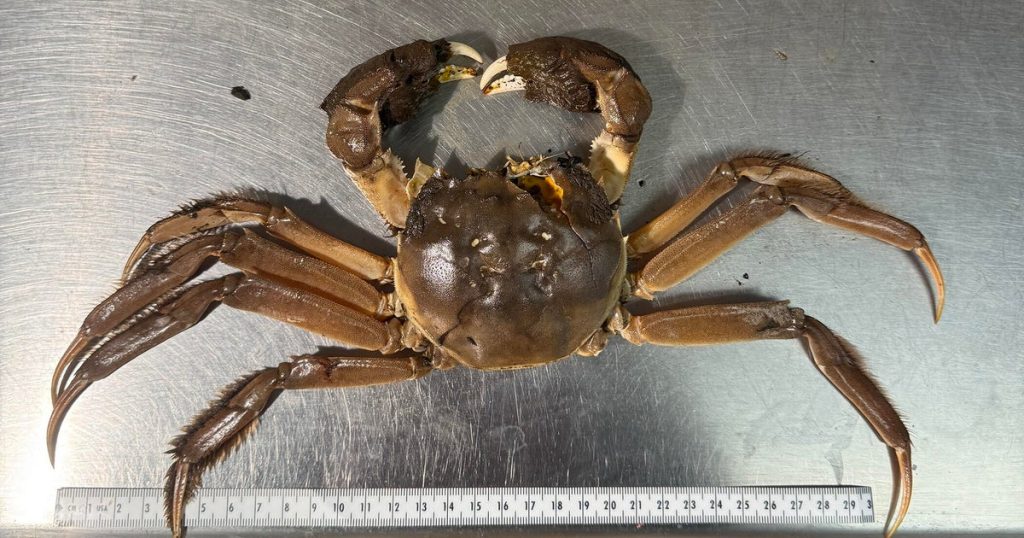In a significant environmental alert, the invasive Chinese mitten crab has been discovered in the Pacific Northwest for the first time, as reported by wildlife officials. Caught by a commercial fisherman in the Lower Columbia River, this species has raised concerns due to its history of ecological damage. Officials from the Oregon Department of Fish and Wildlife are taking steps to evaluate the full extent of this occurrence, considering the potential impact on local ecosystems.
| Article Subheadings |
|---|
| 1) The Discovery of the Chinese Mitten Crab |
| 2) Characteristics of the Chinese Mitten Crab |
| 3) Ecological Impact and Concerns |
| 4) Response from Wildlife Officials |
| 5) Community Awareness and Reporting |
The Discovery of the Chinese Mitten Crab
Recently, a noteworthy event occurred when a commercial fisherman uncovered a Chinese mitten crab in the Lower Columbia River, an area just south of the Washington state border. This particular catch marks the first confirmed sighting of this highly invasive species in the Pacific Northwest, as stated by the Oregon Department of Fish and Wildlife. Prior to this discovery, officials had warned that the Chinese mitten crab was known to wreak havoc on ecosystems, particularly in the San Francisco Bay area, where their population surged in the 1990s.
The Oregon Department of Fish and Wildlife released a statement along with a photograph of the crab, emphasizing that this invasive species could have severe ecological ramifications. The crab, large and male, is suspected to have been introduced into the waters either illegally by an individual or through ballast water discharged from ships. Such introductions can unleash unforeseen consequences on local wildlife and habitats if not properly monitored.
Characteristics of the Chinese Mitten Crab
Chinese mitten crabs are native to East Asia and possess distinct features that set them apart from native crab species. Their name derives from their unique, fur-like claws that resemble mittens, and they exhibit a color range from brownish-orange to greenish-brown. Notably, they also have four spines on each side and a distinct notch between their eyes, traits useful for identification.
One of the most alarming facts about the Chinese mitten crab is its impressive climbing ability. They can ascend concrete structures that rise over 13 feet high, making it feasible for them to traverse waterways that would typically be barriers. Wildlife experts caution that these crabs can navigate through lock systems and potentially scale fish ladders, which poses a significant concern for fish populations and local ecosystems.
Ecological Impact and Concerns
The impact of Chinese mitten crabs on ecosystems is widely documented, with historical precedents demonstrating their propensity to interfere with various environmental systems. Their presence in the San Francisco Bay led to significant ecological and infrastructural damage back in the late 1990s. They have been known to obstruct fishing gear, steal bait, and even hinder power plant operations by clogging cooling systems.
Moreover, these crabs exacerbate flooding risks by burrowing into riverbanks, making them unstable and increasing erosion. Their adaptability, spending most of their lives in freshwater but requiring saltwater for reproduction, complicates their management and underscores the need for vigilance in coastal and riparian ecosystems.
Response from Wildlife Officials
In light of this new discovery, Oregon wildlife biologists are proactively collaborating with the Washington Department of Fish and Wildlife and NOAA to assess whether additional Chinese mitten crabs have made their way into the area. Their strategy includes setting up trap lines and collecting water samples to search for genetic markers specific to this invasive species.
This collaborative effort aims to mitigate any potential ecological disruptions early on. The wildlife officials stress the importance of public involvement in this initiative, urging residents to stay alert for sightings of this crab species.
Community Awareness and Reporting
Community involvement is crucial for effective management of the Chinese mitten crab population. The Oregon Department of Fish and Wildlife encourages the public to report any sightings and provide detailed information about their location to local offices. Effective identification and reporting can lead to swift actions that may prevent the establishment of a sustainable population within local waters.
Officials emphasized the need for accurate reporting to facilitate early detection and control measures. By fostering awareness in the community, wildlife officials can better manage the risks associated with this invasive species and protect local ecosystems from being significantly altered.
| No. | Key Points |
|---|---|
| 1 | The discovery of the Chinese mitten crab marks the first sighting in the Pacific Northwest. |
| 2 | This crab species poses significant ecological and infrastructural risks. |
| 3 | Wildlife officials are conducting studies to assess the extent of the population. |
| 4 | Public reporting is essential for managing this invasive species effectively. |
| 5 | Mitten crabs can climb high structures and impact local fish and infrastructure. |
Summary
The detection of the Chinese mitten crab in the Pacific Northwest serves as a critical reminder of the ongoing challenges posed by invasive species. As wildlife officials mobilize to assess the situation and mitigate risks, community awareness and involvement will be vital in preventing further ecological disruption. The situation underscores the importance of environmental vigilance in preserving local ecosystems.
Frequently Asked Questions
Question: What are Chinese mitten crabs?
Chinese mitten crabs are an invasive species originally from East Asia, characterized by their hairy claws and ability to adapt to various aquatic environments.
Question: Why are Chinese mitten crabs considered a threat?
They pose a significant threat due to their potential to disrupt local ecosystems, damage fishing equipment, block power plant cooling systems, and increase flooding risk through bank erosion.
Question: What should I do if I see a Chinese mitten crab?
If you spot a Chinese mitten crab, it is essential to report your sighting to the local Department of Fish and Wildlife with details about the location to help manage this invasive species.


